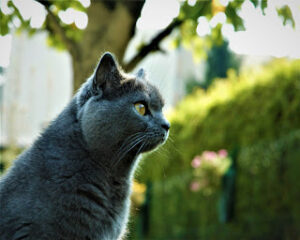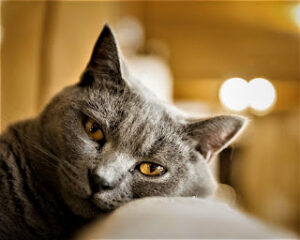The Chartreux Cat A Rare and Enigmatic Feline Companion
Introduction to the Chartreux Cat
The Chartreux cat is one of the most mysterious and captivating feline breeds in the world. Known for its striking blue-gray coat, copper or gold eyes, and sweet smile, this French cat breed has charmed cat lovers for centuries. Often compared to the British Shorthair, the Chartreux stands out with its unique history, quiet demeanor, and loyal personality.
If you’re considering adding a Chartreux to your family or simply want to learn more about this rare breed, this guide covers everything—from their origins and temperament to care tips and fun facts.
History and Origins of the Chartreux Cat
A French Legend
The Chartreux’s history is shrouded in legend. Some believe these cats were brought to France by Crusaders in the Middle Ages, while others think Carthusian monks bred them in the Grand Chartreuse monastery (hence the name). However, historical records confirm their presence in France as early as the 16th century, where they were prized for their mousing skills.
Near Extinction and Revival
World War II nearly wiped out the breed, but dedicated breeders in France and later in the U.S. helped revive the Chartreux in the mid-20th century. Today, they remain a rare but cherished breed, recognized by major cat associations like CFA, TICA, and FIFe.
Physical Characteristics of the Chartreux Cat
Distinctive Blue-Gray Coat
The Chartreux is famous for its dense, water-resistant double coat in shades of blue-gray. Unlike other blue cats, their fur has a slightly woolly texture, making it incredibly soft to the touch.
Copper or Gold Eyes
One of their most mesmerizing features is their large, expressive eyes, ranging from deep gold to bright copper. Kittens are born with blue eyes that gradually change color as they mature.
Medium to Large Build
These cats have a robust, muscular body with a broad chest and strong legs. Males typically weigh 10-16 pounds, while females are slightly smaller at 6-9 pounds.
The “Smiling” Expression
Thanks to their rounded heads and slightly upturned mouths, Chartreux cats often appear to be smiling—a trait that adds to their charm.
Chartreux Cat Personality & Temperament
Gentle and Quiet
Unlike vocal breeds like the Siamese, the Chartreux is famously quiet, communicating with soft chirps and purrs rather than loud meows.
Loyal & Dog-Like
These cats form strong bonds with their families and often follow their favorite humans around the house. Some even play fetch!
Intelligent and Playful
Chartreux cats are quick learners and enjoy puzzle toys, interactive games, and climbing structures. They retain their playful nature well into adulthood.
Good with Children & Other Pets
Their calm and patient demeanor makes them excellent companions for families with kids and other pets, including dogs.
Caring for a Chartreux Cat
Grooming Needs
- Their dense coat requires weekly brushingto prevent matting.
- They shed moderately, with heavier shedding during seasonal changes.
Diet & Nutrition
- A high-protein dietsupports their muscular build.
- Avoid overfeeding, as they can gain weight easily.
Health Considerations
Chartreux cats are generally healthy, but potential issues include:
- Hip dysplasia(rare but possible in some lines)
- Patellar luxation(knee joint issue)
- Dental disease(regular teeth cleaning is recommended)
With proper care, they typically live 12-15 years, with some reaching their late teens.
Fun Facts About the Chartreux Cat
- Literary Fame – The famous French writer Colette owned a Chartreux named “Saha” and featured the breed in her novels.
- National Treasure – In France, the Chartreux is considered a national heritage breed.
- Silent Hunters – Their quiet nature made them excellent mousers in French households.
Is the Chartreux Cat Right for You?
Best For:
- Families with kids or other pets
- Those who want aloyal, low-maintenance cat
- People who appreciate aquiet, affectionate companion
Not Ideal For:
- Those who want a highly vocal cat
- Owners who prefer a tiny or hyperactive breed
The Chartreux cat is a rare gem—gentle, intelligent, and full of quiet charm. Whether you’re drawn to their stunning blue coat, smiling face, or loyal personality, this breed makes a wonderful companion for the right home.
If you’re lucky enough to share your life with a Chartreux, you’ll understand why they’ve been cherished for centuries.
Would you adopt a Chartreux? Let us know in the comments!
Chartreux Cat
Characteristics of the breed
Adaptability 10/10
Attachment to family 10/10
Game activity 04/10
Intelligence 08/10
General Health 09/10
Hair loss 06/10
Child-friendly 08/10
Dog friendly 10/10
Love of meows 02/10
Breed Information
| Country of origin | France |
| Lifetime | 12-15 years |
| Size | medium-large |
| Weight | Cats: 4.5-7 kg, Cats: 3-5 kg |
| Coat type | Shorthair |
| Color | various shades of blue color |
| Lifestyle | outdoors / indoors |
| Price | 1000 – 1500 $ |
History
Chartreux, or Cartesian cat – a beautiful animal of blue color originally from France. The history of these pets dates back to the Middle Ages, due to which they can be considered an aboriginal breed of cats. There are several variants of origin, and all of them are more like legends than a reliably confirmed versions by official sources.
The first legend is associated with Cartesian monks who bred these cats in their monasteries. And they allegedly brought them from Syria. That is, according to this legend, the Chartreux cat breed is of Asian origin, and not French. And the name of the cat breed was given in honor of the monastic monastery of Grand Chartreux.
The second legend, again, is associated with the city of Chartres, which stood at the foot of the mountain, in the vicinity of which there were blue cats of incredible beauty. Their amazing appearance was completed, as it is today, by light orange eyes.
The townspeople interacted with these animals, helping them and giving them housing. In addition, residents pursued a simpler, mercantile goal – to protect warehouses and storerooms from rodents. Subsequently, these cats became popular with the nobility, they were started as beautiful, lively soft toys, which also has useful qualities.
The modern cat Chartreux retains the nobility of previous generations. A large number of these cats were destroyed during the First and Second World Wars. However, in the 50s and later, the population was restored. Perhaps, in part, because such a cat, nicknamed Gris-Gris, was in the legendary general Charles de Gaulle. In the 80s, cats received recognition in the American Cat Fanciers Association, and they appeared in America ten years earlier.
Description
The Chartreux cat breed gives the impression of compactness, thanks to somewhat shortened paws. The body is muscular and strong, with a well-developed chest. Compact size is an apparent point, in fact, this cat in no way belongs to small or small breeds.
They have beautiful, correct faces, medium ears, and orange eyes. The tail is not long. Chartreux is a cat that perfectly fits the concept of a family pet. They live, like most cats, for about 15 years.
Personality
In general, Chartreux is a calm and soft cat. These are animals that avoid conflict situations and give a huge amount of love to their owner and the family in which they live. They are very affectionate, intelligent, and have an understanding of the situation. They can defuse a tense emotional situation simply due to their natural kindness and gentleness. By the way, thanks to these qualities, they are also well suited for families with children.
Cartesian cats are very loyal to their owner, quickly understand what is required of them, rarely go against the grain, and are devoid of aggression or cat whims. They can get along with almost any pet. Preferring to spend time lying down, they are not very active and playful, but, at the same time, the past on the streets of Paris makes itself felt – these cats hunt perfectly.
Common diseases
The Chartreux cat breed has good health and does not have any clearly outstanding inclinations to any serious diseases. But do not forget that good health in itself is not a panacea for all diseases. Especially if the owner himself saves on food and does not provide proper care.
Care
These cats have very beautiful fur, which you will need to take good care of, first of all – during molting. The rest of the time, as usual, it all comes down to combing at least once every two weeks and bathing at least twice a year. Be sure to brush the teeth of the cat, and, it is desirable to do every day. Also, keep your ears clean and remember about nail trimming, which is usually done 2-4 times a month.






